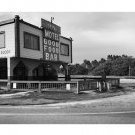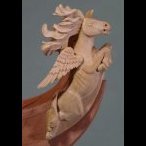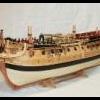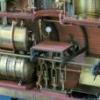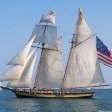MORE HANDBOOKS ARE ON THEIR WAY! We will let you know when they get here.
×
-
Posts
9,532 -
Joined
-
Last visited
Reputation Activity
-
 Chuck reacted to DBorgens in HMS Pegasus by DBorgens – Amati/Victory Models – 1:64
Chuck reacted to DBorgens in HMS Pegasus by DBorgens – Amati/Victory Models – 1:64
Does anyone else find starting the final planking intimidating? I so want to get the run of the strakes reasonably right. So I spent much time marking the location of the wales and the waterline (for reference). Judging from the plans the wale should be a few millimeters above the waterline at the waist. Having set the lines, it’s time to get started.
I am using Chuck’s method of edge bending using dry heat. Practicing with a walnut strip, I found it fast and actually fairly easy. Switching to the boxwood plank, I formed the edge curve, then I formed it around the bow (actually freehand by holding the plank against a board to approximate the bend needed). The plank also has a twist at the stern which I carefully heated in place on the hull (covering iron perfect for this). I glued the strip in place without much force. So far I am liking the dry bending method.
Dave B
-
 Chuck got a reaction from FrankWouts in HMS Winchelsea - FINISHED - 1764 - by Chuck (1/4" scale)
Chuck got a reaction from FrankWouts in HMS Winchelsea - FINISHED - 1764 - by Chuck (1/4" scale)
Thank You fellas
Today I added the waterway on top of the margin planks. Originally I was going to use a 1/16" x 1/16" strip. But after some thought I switched and used a 3/64" x 3/64" strip of cedar. I carefully sanded away one corner so the strip was like a quarter round molding. Then I glued it along the bulwarks.
Then it was time for the checker pattern floor in the great cabin. This is 3/64" thick. It is laser etched with the pattern as you can see. It is cut over-sized so with a little tweaking it should fit everyone's model. So it is crucial that you make a paper pattern first that fits in the space tight. Then trace it on the sheet and cut it to fit your model. Try for a nice tight fit!!! I prefer a subtle pattern that isnt too dark. So many models end up with a black and white pattern which I find so distracting.
Remember where the forward bulkhead will be so you position the forward edge correctly. My floor ends right under where the deck beam will be so I know the bulkhead will sit on top of the edge of the checker pattern.
From this point, I will slowly make my way forward building the various coamings and partners. This needs to be done so we can plank the deck properly around these items. You can see that the one coaming and grating was completed. I wont add the ladder until later. But I did manage to build the capstan partners.
The capstan partner sits against the coaming. It is also laser cut in three pieces and glues together quickly. I simulated the seams between each section. I also softened the top edge because it shouldnt be a hard edge.
One interesting feature about the partners is that it should NOT be glued directly to the false deck. The deck is sloped which is to be expected. But the partners need to be level otherwise the capstan will not work properly. This means the forward edge of the partners need to be lifted a bit to raise it up and level it off. I did this with a little cheat. I added a small length of a 1/32" strip under the forward edge which will be covered up after we plank the deck. You will notice how it looks lifted up on the forward side and level. If you need to sand the bottom of the aft edge a bit to make it level then that is OK also.
I simulated the bolts using 20 pound black monfilament. You guys should pick some up in various sizes as we will be using it a lot throught the model.
Chuck
-
 Chuck got a reaction from ccoyle in HMS Winchelsea - FINISHED - 1764 - by Chuck (1/4" scale)
Chuck got a reaction from ccoyle in HMS Winchelsea - FINISHED - 1764 - by Chuck (1/4" scale)
Thank You fellas
Today I added the waterway on top of the margin planks. Originally I was going to use a 1/16" x 1/16" strip. But after some thought I switched and used a 3/64" x 3/64" strip of cedar. I carefully sanded away one corner so the strip was like a quarter round molding. Then I glued it along the bulwarks.
Then it was time for the checker pattern floor in the great cabin. This is 3/64" thick. It is laser etched with the pattern as you can see. It is cut over-sized so with a little tweaking it should fit everyone's model. So it is crucial that you make a paper pattern first that fits in the space tight. Then trace it on the sheet and cut it to fit your model. Try for a nice tight fit!!! I prefer a subtle pattern that isnt too dark. So many models end up with a black and white pattern which I find so distracting.
Remember where the forward bulkhead will be so you position the forward edge correctly. My floor ends right under where the deck beam will be so I know the bulkhead will sit on top of the edge of the checker pattern.
From this point, I will slowly make my way forward building the various coamings and partners. This needs to be done so we can plank the deck properly around these items. You can see that the one coaming and grating was completed. I wont add the ladder until later. But I did manage to build the capstan partners.
The capstan partner sits against the coaming. It is also laser cut in three pieces and glues together quickly. I simulated the seams between each section. I also softened the top edge because it shouldnt be a hard edge.
One interesting feature about the partners is that it should NOT be glued directly to the false deck. The deck is sloped which is to be expected. But the partners need to be level otherwise the capstan will not work properly. This means the forward edge of the partners need to be lifted a bit to raise it up and level it off. I did this with a little cheat. I added a small length of a 1/32" strip under the forward edge which will be covered up after we plank the deck. You will notice how it looks lifted up on the forward side and level. If you need to sand the bottom of the aft edge a bit to make it level then that is OK also.
I simulated the bolts using 20 pound black monfilament. You guys should pick some up in various sizes as we will be using it a lot throught the model.
Chuck
-
 Chuck got a reaction from iosto in HMS Winchelsea - FINISHED - 1764 - by Chuck (1/4" scale)
Chuck got a reaction from iosto in HMS Winchelsea - FINISHED - 1764 - by Chuck (1/4" scale)
Thank You fellas
Today I added the waterway on top of the margin planks. Originally I was going to use a 1/16" x 1/16" strip. But after some thought I switched and used a 3/64" x 3/64" strip of cedar. I carefully sanded away one corner so the strip was like a quarter round molding. Then I glued it along the bulwarks.
Then it was time for the checker pattern floor in the great cabin. This is 3/64" thick. It is laser etched with the pattern as you can see. It is cut over-sized so with a little tweaking it should fit everyone's model. So it is crucial that you make a paper pattern first that fits in the space tight. Then trace it on the sheet and cut it to fit your model. Try for a nice tight fit!!! I prefer a subtle pattern that isnt too dark. So many models end up with a black and white pattern which I find so distracting.
Remember where the forward bulkhead will be so you position the forward edge correctly. My floor ends right under where the deck beam will be so I know the bulkhead will sit on top of the edge of the checker pattern.
From this point, I will slowly make my way forward building the various coamings and partners. This needs to be done so we can plank the deck properly around these items. You can see that the one coaming and grating was completed. I wont add the ladder until later. But I did manage to build the capstan partners.
The capstan partner sits against the coaming. It is also laser cut in three pieces and glues together quickly. I simulated the seams between each section. I also softened the top edge because it shouldnt be a hard edge.
One interesting feature about the partners is that it should NOT be glued directly to the false deck. The deck is sloped which is to be expected. But the partners need to be level otherwise the capstan will not work properly. This means the forward edge of the partners need to be lifted a bit to raise it up and level it off. I did this with a little cheat. I added a small length of a 1/32" strip under the forward edge which will be covered up after we plank the deck. You will notice how it looks lifted up on the forward side and level. If you need to sand the bottom of the aft edge a bit to make it level then that is OK also.
I simulated the bolts using 20 pound black monfilament. You guys should pick some up in various sizes as we will be using it a lot throught the model.
Chuck
-
 Chuck got a reaction from Peter Bloemendaal in HMS Winchelsea - FINISHED - 1764 - by Chuck (1/4" scale)
Chuck got a reaction from Peter Bloemendaal in HMS Winchelsea - FINISHED - 1764 - by Chuck (1/4" scale)
Thank You fellas
Today I added the waterway on top of the margin planks. Originally I was going to use a 1/16" x 1/16" strip. But after some thought I switched and used a 3/64" x 3/64" strip of cedar. I carefully sanded away one corner so the strip was like a quarter round molding. Then I glued it along the bulwarks.
Then it was time for the checker pattern floor in the great cabin. This is 3/64" thick. It is laser etched with the pattern as you can see. It is cut over-sized so with a little tweaking it should fit everyone's model. So it is crucial that you make a paper pattern first that fits in the space tight. Then trace it on the sheet and cut it to fit your model. Try for a nice tight fit!!! I prefer a subtle pattern that isnt too dark. So many models end up with a black and white pattern which I find so distracting.
Remember where the forward bulkhead will be so you position the forward edge correctly. My floor ends right under where the deck beam will be so I know the bulkhead will sit on top of the edge of the checker pattern.
From this point, I will slowly make my way forward building the various coamings and partners. This needs to be done so we can plank the deck properly around these items. You can see that the one coaming and grating was completed. I wont add the ladder until later. But I did manage to build the capstan partners.
The capstan partner sits against the coaming. It is also laser cut in three pieces and glues together quickly. I simulated the seams between each section. I also softened the top edge because it shouldnt be a hard edge.
One interesting feature about the partners is that it should NOT be glued directly to the false deck. The deck is sloped which is to be expected. But the partners need to be level otherwise the capstan will not work properly. This means the forward edge of the partners need to be lifted a bit to raise it up and level it off. I did this with a little cheat. I added a small length of a 1/32" strip under the forward edge which will be covered up after we plank the deck. You will notice how it looks lifted up on the forward side and level. If you need to sand the bottom of the aft edge a bit to make it level then that is OK also.
I simulated the bolts using 20 pound black monfilament. You guys should pick some up in various sizes as we will be using it a lot throught the model.
Chuck
-
 Chuck got a reaction from realworkingsailor in HMS Winchelsea - FINISHED - 1764 - by Chuck (1/4" scale)
Chuck got a reaction from realworkingsailor in HMS Winchelsea - FINISHED - 1764 - by Chuck (1/4" scale)
Thank You fellas
Today I added the waterway on top of the margin planks. Originally I was going to use a 1/16" x 1/16" strip. But after some thought I switched and used a 3/64" x 3/64" strip of cedar. I carefully sanded away one corner so the strip was like a quarter round molding. Then I glued it along the bulwarks.
Then it was time for the checker pattern floor in the great cabin. This is 3/64" thick. It is laser etched with the pattern as you can see. It is cut over-sized so with a little tweaking it should fit everyone's model. So it is crucial that you make a paper pattern first that fits in the space tight. Then trace it on the sheet and cut it to fit your model. Try for a nice tight fit!!! I prefer a subtle pattern that isnt too dark. So many models end up with a black and white pattern which I find so distracting.
Remember where the forward bulkhead will be so you position the forward edge correctly. My floor ends right under where the deck beam will be so I know the bulkhead will sit on top of the edge of the checker pattern.
From this point, I will slowly make my way forward building the various coamings and partners. This needs to be done so we can plank the deck properly around these items. You can see that the one coaming and grating was completed. I wont add the ladder until later. But I did manage to build the capstan partners.
The capstan partner sits against the coaming. It is also laser cut in three pieces and glues together quickly. I simulated the seams between each section. I also softened the top edge because it shouldnt be a hard edge.
One interesting feature about the partners is that it should NOT be glued directly to the false deck. The deck is sloped which is to be expected. But the partners need to be level otherwise the capstan will not work properly. This means the forward edge of the partners need to be lifted a bit to raise it up and level it off. I did this with a little cheat. I added a small length of a 1/32" strip under the forward edge which will be covered up after we plank the deck. You will notice how it looks lifted up on the forward side and level. If you need to sand the bottom of the aft edge a bit to make it level then that is OK also.
I simulated the bolts using 20 pound black monfilament. You guys should pick some up in various sizes as we will be using it a lot throught the model.
Chuck
-
 Chuck got a reaction from Jorge Diaz O in HMS Winchelsea - FINISHED - 1764 - by Chuck (1/4" scale)
Chuck got a reaction from Jorge Diaz O in HMS Winchelsea - FINISHED - 1764 - by Chuck (1/4" scale)
Thank You fellas
Today I added the waterway on top of the margin planks. Originally I was going to use a 1/16" x 1/16" strip. But after some thought I switched and used a 3/64" x 3/64" strip of cedar. I carefully sanded away one corner so the strip was like a quarter round molding. Then I glued it along the bulwarks.
Then it was time for the checker pattern floor in the great cabin. This is 3/64" thick. It is laser etched with the pattern as you can see. It is cut over-sized so with a little tweaking it should fit everyone's model. So it is crucial that you make a paper pattern first that fits in the space tight. Then trace it on the sheet and cut it to fit your model. Try for a nice tight fit!!! I prefer a subtle pattern that isnt too dark. So many models end up with a black and white pattern which I find so distracting.
Remember where the forward bulkhead will be so you position the forward edge correctly. My floor ends right under where the deck beam will be so I know the bulkhead will sit on top of the edge of the checker pattern.
From this point, I will slowly make my way forward building the various coamings and partners. This needs to be done so we can plank the deck properly around these items. You can see that the one coaming and grating was completed. I wont add the ladder until later. But I did manage to build the capstan partners.
The capstan partner sits against the coaming. It is also laser cut in three pieces and glues together quickly. I simulated the seams between each section. I also softened the top edge because it shouldnt be a hard edge.
One interesting feature about the partners is that it should NOT be glued directly to the false deck. The deck is sloped which is to be expected. But the partners need to be level otherwise the capstan will not work properly. This means the forward edge of the partners need to be lifted a bit to raise it up and level it off. I did this with a little cheat. I added a small length of a 1/32" strip under the forward edge which will be covered up after we plank the deck. You will notice how it looks lifted up on the forward side and level. If you need to sand the bottom of the aft edge a bit to make it level then that is OK also.
I simulated the bolts using 20 pound black monfilament. You guys should pick some up in various sizes as we will be using it a lot throught the model.
Chuck
-
 Chuck got a reaction from egkb in HMS Winchelsea - FINISHED - 1764 - by Chuck (1/4" scale)
Chuck got a reaction from egkb in HMS Winchelsea - FINISHED - 1764 - by Chuck (1/4" scale)
Thank You fellas
Today I added the waterway on top of the margin planks. Originally I was going to use a 1/16" x 1/16" strip. But after some thought I switched and used a 3/64" x 3/64" strip of cedar. I carefully sanded away one corner so the strip was like a quarter round molding. Then I glued it along the bulwarks.
Then it was time for the checker pattern floor in the great cabin. This is 3/64" thick. It is laser etched with the pattern as you can see. It is cut over-sized so with a little tweaking it should fit everyone's model. So it is crucial that you make a paper pattern first that fits in the space tight. Then trace it on the sheet and cut it to fit your model. Try for a nice tight fit!!! I prefer a subtle pattern that isnt too dark. So many models end up with a black and white pattern which I find so distracting.
Remember where the forward bulkhead will be so you position the forward edge correctly. My floor ends right under where the deck beam will be so I know the bulkhead will sit on top of the edge of the checker pattern.
From this point, I will slowly make my way forward building the various coamings and partners. This needs to be done so we can plank the deck properly around these items. You can see that the one coaming and grating was completed. I wont add the ladder until later. But I did manage to build the capstan partners.
The capstan partner sits against the coaming. It is also laser cut in three pieces and glues together quickly. I simulated the seams between each section. I also softened the top edge because it shouldnt be a hard edge.
One interesting feature about the partners is that it should NOT be glued directly to the false deck. The deck is sloped which is to be expected. But the partners need to be level otherwise the capstan will not work properly. This means the forward edge of the partners need to be lifted a bit to raise it up and level it off. I did this with a little cheat. I added a small length of a 1/32" strip under the forward edge which will be covered up after we plank the deck. You will notice how it looks lifted up on the forward side and level. If you need to sand the bottom of the aft edge a bit to make it level then that is OK also.
I simulated the bolts using 20 pound black monfilament. You guys should pick some up in various sizes as we will be using it a lot throught the model.
Chuck
-
 Chuck got a reaction from Matt D in HMS Winchelsea - FINISHED - 1764 - by Chuck (1/4" scale)
Chuck got a reaction from Matt D in HMS Winchelsea - FINISHED - 1764 - by Chuck (1/4" scale)
Thank You fellas
Today I added the waterway on top of the margin planks. Originally I was going to use a 1/16" x 1/16" strip. But after some thought I switched and used a 3/64" x 3/64" strip of cedar. I carefully sanded away one corner so the strip was like a quarter round molding. Then I glued it along the bulwarks.
Then it was time for the checker pattern floor in the great cabin. This is 3/64" thick. It is laser etched with the pattern as you can see. It is cut over-sized so with a little tweaking it should fit everyone's model. So it is crucial that you make a paper pattern first that fits in the space tight. Then trace it on the sheet and cut it to fit your model. Try for a nice tight fit!!! I prefer a subtle pattern that isnt too dark. So many models end up with a black and white pattern which I find so distracting.
Remember where the forward bulkhead will be so you position the forward edge correctly. My floor ends right under where the deck beam will be so I know the bulkhead will sit on top of the edge of the checker pattern.
From this point, I will slowly make my way forward building the various coamings and partners. This needs to be done so we can plank the deck properly around these items. You can see that the one coaming and grating was completed. I wont add the ladder until later. But I did manage to build the capstan partners.
The capstan partner sits against the coaming. It is also laser cut in three pieces and glues together quickly. I simulated the seams between each section. I also softened the top edge because it shouldnt be a hard edge.
One interesting feature about the partners is that it should NOT be glued directly to the false deck. The deck is sloped which is to be expected. But the partners need to be level otherwise the capstan will not work properly. This means the forward edge of the partners need to be lifted a bit to raise it up and level it off. I did this with a little cheat. I added a small length of a 1/32" strip under the forward edge which will be covered up after we plank the deck. You will notice how it looks lifted up on the forward side and level. If you need to sand the bottom of the aft edge a bit to make it level then that is OK also.
I simulated the bolts using 20 pound black monfilament. You guys should pick some up in various sizes as we will be using it a lot throught the model.
Chuck
-
 Chuck got a reaction from VTHokiEE in HMS Winchelsea - FINISHED - 1764 - by Chuck (1/4" scale)
Chuck got a reaction from VTHokiEE in HMS Winchelsea - FINISHED - 1764 - by Chuck (1/4" scale)
Thank You fellas
Today I added the waterway on top of the margin planks. Originally I was going to use a 1/16" x 1/16" strip. But after some thought I switched and used a 3/64" x 3/64" strip of cedar. I carefully sanded away one corner so the strip was like a quarter round molding. Then I glued it along the bulwarks.
Then it was time for the checker pattern floor in the great cabin. This is 3/64" thick. It is laser etched with the pattern as you can see. It is cut over-sized so with a little tweaking it should fit everyone's model. So it is crucial that you make a paper pattern first that fits in the space tight. Then trace it on the sheet and cut it to fit your model. Try for a nice tight fit!!! I prefer a subtle pattern that isnt too dark. So many models end up with a black and white pattern which I find so distracting.
Remember where the forward bulkhead will be so you position the forward edge correctly. My floor ends right under where the deck beam will be so I know the bulkhead will sit on top of the edge of the checker pattern.
From this point, I will slowly make my way forward building the various coamings and partners. This needs to be done so we can plank the deck properly around these items. You can see that the one coaming and grating was completed. I wont add the ladder until later. But I did manage to build the capstan partners.
The capstan partner sits against the coaming. It is also laser cut in three pieces and glues together quickly. I simulated the seams between each section. I also softened the top edge because it shouldnt be a hard edge.
One interesting feature about the partners is that it should NOT be glued directly to the false deck. The deck is sloped which is to be expected. But the partners need to be level otherwise the capstan will not work properly. This means the forward edge of the partners need to be lifted a bit to raise it up and level it off. I did this with a little cheat. I added a small length of a 1/32" strip under the forward edge which will be covered up after we plank the deck. You will notice how it looks lifted up on the forward side and level. If you need to sand the bottom of the aft edge a bit to make it level then that is OK also.
I simulated the bolts using 20 pound black monfilament. You guys should pick some up in various sizes as we will be using it a lot throught the model.
Chuck
-
 Chuck got a reaction from FrankWouts in HMS Winchelsea - FINISHED - 1764 - by Chuck (1/4" scale)
Chuck got a reaction from FrankWouts in HMS Winchelsea - FINISHED - 1764 - by Chuck (1/4" scale)
Next up it was time to add the second layer of spirketting (the lower two strakes) and the 7/32" wide plank above the ports. I used planks that were the same width but just 1/32" thick. You can even sand them thinner if you like. I also added the aft shell for fixed block. See it forward of the panelling? This should be added at this stage so you can plank the second layer around it.
Note how I also added one more 1/32" second layer strake above that 7/32" wide strip. The top edge follows along the bottom of the notches in the deck clamp. I use various width strips because you will need to taper it. It is not a consistent width. Just make sure the top edge is flush with the bottom of the notches in the deck clamp. MOST important....look at the forward end of this additional trip. Notice where it starts in relationship to the first notch in the deck clamp. This is important because it will aid you later when we build the platforms for the gangways.
Here is a view of the bow area. Same things apply. Notice where the aft end of the plank ends in this instance. Once again it is even with that first notch.
Sand everything smooth and prep the bulwarks for painting. Then paint it red. But dont paint the fancy panels aft. Here is what my model looks like at this stage. I still have to complete the port side....havent started planking that yet.
-
 Chuck got a reaction from Jim Rogers in HMS Winchelsea - FINISHED - 1764 - by Chuck (1/4" scale)
Chuck got a reaction from Jim Rogers in HMS Winchelsea - FINISHED - 1764 - by Chuck (1/4" scale)
Thank You fellas
Today I added the waterway on top of the margin planks. Originally I was going to use a 1/16" x 1/16" strip. But after some thought I switched and used a 3/64" x 3/64" strip of cedar. I carefully sanded away one corner so the strip was like a quarter round molding. Then I glued it along the bulwarks.
Then it was time for the checker pattern floor in the great cabin. This is 3/64" thick. It is laser etched with the pattern as you can see. It is cut over-sized so with a little tweaking it should fit everyone's model. So it is crucial that you make a paper pattern first that fits in the space tight. Then trace it on the sheet and cut it to fit your model. Try for a nice tight fit!!! I prefer a subtle pattern that isnt too dark. So many models end up with a black and white pattern which I find so distracting.
Remember where the forward bulkhead will be so you position the forward edge correctly. My floor ends right under where the deck beam will be so I know the bulkhead will sit on top of the edge of the checker pattern.
From this point, I will slowly make my way forward building the various coamings and partners. This needs to be done so we can plank the deck properly around these items. You can see that the one coaming and grating was completed. I wont add the ladder until later. But I did manage to build the capstan partners.
The capstan partner sits against the coaming. It is also laser cut in three pieces and glues together quickly. I simulated the seams between each section. I also softened the top edge because it shouldnt be a hard edge.
One interesting feature about the partners is that it should NOT be glued directly to the false deck. The deck is sloped which is to be expected. But the partners need to be level otherwise the capstan will not work properly. This means the forward edge of the partners need to be lifted a bit to raise it up and level it off. I did this with a little cheat. I added a small length of a 1/32" strip under the forward edge which will be covered up after we plank the deck. You will notice how it looks lifted up on the forward side and level. If you need to sand the bottom of the aft edge a bit to make it level then that is OK also.
I simulated the bolts using 20 pound black monfilament. You guys should pick some up in various sizes as we will be using it a lot throught the model.
Chuck
-
 Chuck got a reaction from Trussben in HMS Winchelsea - FINISHED - 1764 - by Chuck (1/4" scale)
Chuck got a reaction from Trussben in HMS Winchelsea - FINISHED - 1764 - by Chuck (1/4" scale)
Thank You fellas
Today I added the waterway on top of the margin planks. Originally I was going to use a 1/16" x 1/16" strip. But after some thought I switched and used a 3/64" x 3/64" strip of cedar. I carefully sanded away one corner so the strip was like a quarter round molding. Then I glued it along the bulwarks.
Then it was time for the checker pattern floor in the great cabin. This is 3/64" thick. It is laser etched with the pattern as you can see. It is cut over-sized so with a little tweaking it should fit everyone's model. So it is crucial that you make a paper pattern first that fits in the space tight. Then trace it on the sheet and cut it to fit your model. Try for a nice tight fit!!! I prefer a subtle pattern that isnt too dark. So many models end up with a black and white pattern which I find so distracting.
Remember where the forward bulkhead will be so you position the forward edge correctly. My floor ends right under where the deck beam will be so I know the bulkhead will sit on top of the edge of the checker pattern.
From this point, I will slowly make my way forward building the various coamings and partners. This needs to be done so we can plank the deck properly around these items. You can see that the one coaming and grating was completed. I wont add the ladder until later. But I did manage to build the capstan partners.
The capstan partner sits against the coaming. It is also laser cut in three pieces and glues together quickly. I simulated the seams between each section. I also softened the top edge because it shouldnt be a hard edge.
One interesting feature about the partners is that it should NOT be glued directly to the false deck. The deck is sloped which is to be expected. But the partners need to be level otherwise the capstan will not work properly. This means the forward edge of the partners need to be lifted a bit to raise it up and level it off. I did this with a little cheat. I added a small length of a 1/32" strip under the forward edge which will be covered up after we plank the deck. You will notice how it looks lifted up on the forward side and level. If you need to sand the bottom of the aft edge a bit to make it level then that is OK also.
I simulated the bolts using 20 pound black monfilament. You guys should pick some up in various sizes as we will be using it a lot throught the model.
Chuck
-
 Chuck got a reaction from Rustyj in HMS Winchelsea - FINISHED - 1764 - by Chuck (1/4" scale)
Chuck got a reaction from Rustyj in HMS Winchelsea - FINISHED - 1764 - by Chuck (1/4" scale)
Thank You fellas
Today I added the waterway on top of the margin planks. Originally I was going to use a 1/16" x 1/16" strip. But after some thought I switched and used a 3/64" x 3/64" strip of cedar. I carefully sanded away one corner so the strip was like a quarter round molding. Then I glued it along the bulwarks.
Then it was time for the checker pattern floor in the great cabin. This is 3/64" thick. It is laser etched with the pattern as you can see. It is cut over-sized so with a little tweaking it should fit everyone's model. So it is crucial that you make a paper pattern first that fits in the space tight. Then trace it on the sheet and cut it to fit your model. Try for a nice tight fit!!! I prefer a subtle pattern that isnt too dark. So many models end up with a black and white pattern which I find so distracting.
Remember where the forward bulkhead will be so you position the forward edge correctly. My floor ends right under where the deck beam will be so I know the bulkhead will sit on top of the edge of the checker pattern.
From this point, I will slowly make my way forward building the various coamings and partners. This needs to be done so we can plank the deck properly around these items. You can see that the one coaming and grating was completed. I wont add the ladder until later. But I did manage to build the capstan partners.
The capstan partner sits against the coaming. It is also laser cut in three pieces and glues together quickly. I simulated the seams between each section. I also softened the top edge because it shouldnt be a hard edge.
One interesting feature about the partners is that it should NOT be glued directly to the false deck. The deck is sloped which is to be expected. But the partners need to be level otherwise the capstan will not work properly. This means the forward edge of the partners need to be lifted a bit to raise it up and level it off. I did this with a little cheat. I added a small length of a 1/32" strip under the forward edge which will be covered up after we plank the deck. You will notice how it looks lifted up on the forward side and level. If you need to sand the bottom of the aft edge a bit to make it level then that is OK also.
I simulated the bolts using 20 pound black monfilament. You guys should pick some up in various sizes as we will be using it a lot throught the model.
Chuck
-
 Chuck got a reaction from Gahm in HMS Winchelsea - FINISHED - 1764 - by Chuck (1/4" scale)
Chuck got a reaction from Gahm in HMS Winchelsea - FINISHED - 1764 - by Chuck (1/4" scale)
Thank You fellas
Today I added the waterway on top of the margin planks. Originally I was going to use a 1/16" x 1/16" strip. But after some thought I switched and used a 3/64" x 3/64" strip of cedar. I carefully sanded away one corner so the strip was like a quarter round molding. Then I glued it along the bulwarks.
Then it was time for the checker pattern floor in the great cabin. This is 3/64" thick. It is laser etched with the pattern as you can see. It is cut over-sized so with a little tweaking it should fit everyone's model. So it is crucial that you make a paper pattern first that fits in the space tight. Then trace it on the sheet and cut it to fit your model. Try for a nice tight fit!!! I prefer a subtle pattern that isnt too dark. So many models end up with a black and white pattern which I find so distracting.
Remember where the forward bulkhead will be so you position the forward edge correctly. My floor ends right under where the deck beam will be so I know the bulkhead will sit on top of the edge of the checker pattern.
From this point, I will slowly make my way forward building the various coamings and partners. This needs to be done so we can plank the deck properly around these items. You can see that the one coaming and grating was completed. I wont add the ladder until later. But I did manage to build the capstan partners.
The capstan partner sits against the coaming. It is also laser cut in three pieces and glues together quickly. I simulated the seams between each section. I also softened the top edge because it shouldnt be a hard edge.
One interesting feature about the partners is that it should NOT be glued directly to the false deck. The deck is sloped which is to be expected. But the partners need to be level otherwise the capstan will not work properly. This means the forward edge of the partners need to be lifted a bit to raise it up and level it off. I did this with a little cheat. I added a small length of a 1/32" strip under the forward edge which will be covered up after we plank the deck. You will notice how it looks lifted up on the forward side and level. If you need to sand the bottom of the aft edge a bit to make it level then that is OK also.
I simulated the bolts using 20 pound black monfilament. You guys should pick some up in various sizes as we will be using it a lot throught the model.
Chuck
-
 Chuck reacted to JpR62 in HMS Winchelsea - FINISHED - 1764 - by Chuck (1/4" scale)
Chuck reacted to JpR62 in HMS Winchelsea - FINISHED - 1764 - by Chuck (1/4" scale)
Always a real pleasure to follow this wonderful build. Thank you Chuck !
-
 Chuck got a reaction from MEDDO in Queen Anne Barge by MEDDO - FINISHED - Syren - scale 1:24
Chuck got a reaction from MEDDO in Queen Anne Barge by MEDDO - FINISHED - Syren - scale 1:24
I have already sprayed them so you are good to go. BUT you may want to lightly spray again if want. Use a matte spray fixative is best. Hairspray is a last resort.
-
 Chuck got a reaction from Saburo in HMS Winchelsea 1764 by Matt D 1:48
Chuck got a reaction from Saburo in HMS Winchelsea 1764 by Matt D 1:48
Its all a learning process. If you can get through planking this hull I am sure your next project will be even better.
-
 Chuck got a reaction from BobG in Queen Anne Barge by MEDDO - FINISHED - Syren - scale 1:24
Chuck got a reaction from BobG in Queen Anne Barge by MEDDO - FINISHED - Syren - scale 1:24
I have already sprayed them so you are good to go. BUT you may want to lightly spray again if want. Use a matte spray fixative is best. Hairspray is a last resort.
-
 Chuck got a reaction from MEDDO in Queen Anne Barge by MEDDO - FINISHED - Syren - scale 1:24
Chuck got a reaction from MEDDO in Queen Anne Barge by MEDDO - FINISHED - Syren - scale 1:24
That is turning out terrific. Nice job with the painting. You are gettin close now.
-
 Chuck got a reaction from Saburo in HM Cutter Cheerful 1806 by glbarlow - FINISHED - 1:48
Chuck got a reaction from Saburo in HM Cutter Cheerful 1806 by glbarlow - FINISHED - 1:48
Its really coming together Glenn. Looks really good so far.
-
 Chuck got a reaction from FrankWouts in HMS Winchelsea 1764 by Matt D 1:48
Chuck got a reaction from FrankWouts in HMS Winchelsea 1764 by Matt D 1:48
Its all a learning process. If you can get through planking this hull I am sure your next project will be even better.
-
 Chuck reacted to Richvee in Kate Cory by Richvee - FINISHED - Model Shipways - 1:64 - solid hull
Chuck reacted to Richvee in Kate Cory by Richvee - FINISHED - Model Shipways - 1:64 - solid hull
Closing in on finishing the last two whaleboats. Some painting, cuddy board details (Loggerhead, cleat, steering oar brace), oarlocks, thwart knees, foot brace, lifting eyes, and they'll be done. (Wow...actually there's quite a few details I still need to add 🙂)
I'll save the gear for when I need a break from rigging.
I'm going to load all 3 boats on the davits with gear, and leave the spare boat on the tail feathers empty. I know the boats weren't fully loaded until they were about to embark on a chase, but for display purposes, that's the way I'm going to go. Hey, if it's good enough for Ronnberg's KC in New Bedford, it'll be OK for mine as well.
Once I have these little guys finished, I can temporarily set them in their places on the ship so I can get the davits at the correct height and aligned with the lifting eyes on the boats. Then I can go ahead and get the blocks on the davits, and secure the davits permanently in place, and add the davit braces.
Work has begun on shaping the boom, gaff, and yards. I'm fortunate to still be working through this crisis, but work is slow with lots of down time, so I've been bringing the yards to work and sanding and shaping to pass the day. I've got the boom, gaff , lower and topsail yards shaped, but I haven't trimmed the lengths yet. The plan is to have these ready to paint and start adding details to them as soon as the whaleboats are done.
-
 Chuck reacted to CharlieZardoz in 19th Century 31-ton Revenue Cutter by CharlieZardoz - Scale 1/64 - building as USRC Active based off Doughty plans and BlueJacket Shipcrafters kit
Chuck reacted to CharlieZardoz in 19th Century 31-ton Revenue Cutter by CharlieZardoz - Scale 1/64 - building as USRC Active based off Doughty plans and BlueJacket Shipcrafters kit
Good morning! Decided to do a mini-update today I added all the treenails to the finished side of the hull. Basically I the process was poking them out with an awl then filling the hole with colored putty (which I darkened with paint) then used the colored pencil to define the area a bit more and here is how it looks! I know some of my steelers are a bit off location but that will be colored with copper anyways. I realize now that the nails are effectively showing where the ships frames are (an obvious concept but I now I see the logic behind it). Next step now will be doing the other side hopefully won't take me nearly as long
-
 Chuck got a reaction from FrankWouts in HMS Winchelsea - FINISHED - 1764 - by Chuck (1/4" scale)
Chuck got a reaction from FrankWouts in HMS Winchelsea - FINISHED - 1764 - by Chuck (1/4" scale)
Today I planked the inboard stern. There are five strakes. They are all laser cut with the proper curve. Note that I started with the top plank so it would be flush with the bottoms of the windows. We will be adding a thin sill and some molding later on top of this to finish it off. Excuse the dust!!! But each new addition does clean every up a bit and make it look nicer covering up all of the frames and bulkheads. I also decided NOT to high light the seams between these planks as I think they would look too busy. It will look cleaner this way with the paneled rudder trunk and benches in front of it.
Also not how the bottom three planks dont span the entire width of the stern. The center will be left open for the rudder and this whole area will be covered with the paneled rudder trunk. In fact we will be adding the rudder real soon.
But first I want to get the deck planked. So next up was adding the margin planks. These are also laser cut with scarfs. But be aware that it is unlikely that these will fit your model perfectly. There will be so many differences in the way each of you fair inboard and create the inboard shape of the hull. So some of you will no doubt have to use them as a starting point to trace them and cut new ones to fit your model. Its not very hard to do. They are 3/64" thick. The aft section against the transom was positioned first. The aft edge was beveled to fit snug against the transom.
Then I started adding each of the four sections along each side. Starting at the bow and working my way aft.
Next up I will add the waterway which will be a 1/16" x 1/16" strip that is angled on the inboard side. You know the drill. Its the same way as done with all of my projects. Once that is done I will start building the platforms and coaming down the center of the deck so I can plank around them. Here is how she looks now. Testing the deck beams too!!!

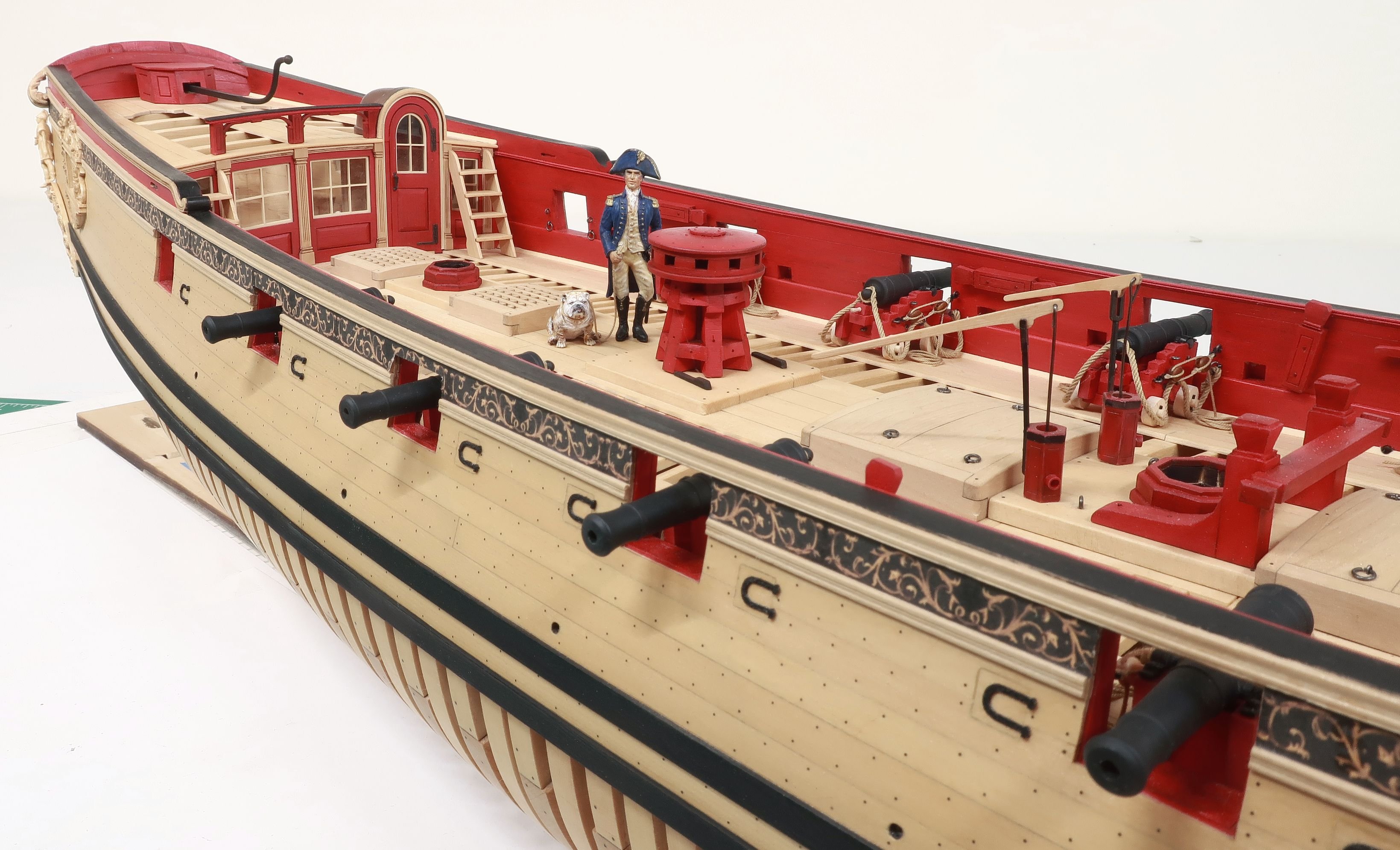
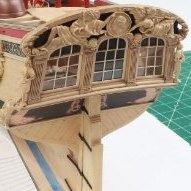


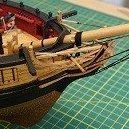

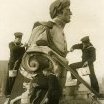

.thumb.jpg.6d6ee4bdbfaac2c58ecc77e7b80ae374.jpg)
